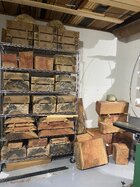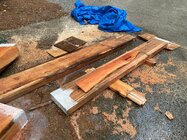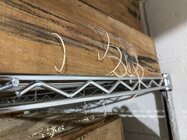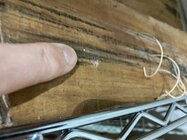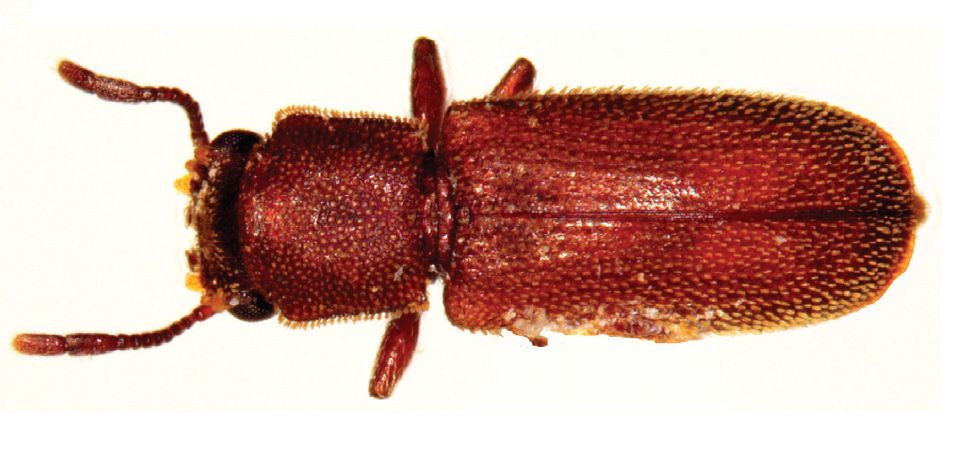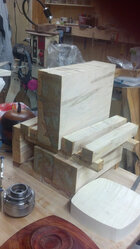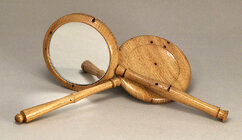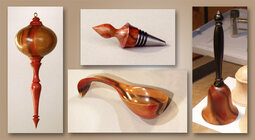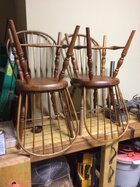I mostly only boil Arbutus (Madrone) because it cracks so badly and very quickly in warm weather its not suitable for turning.
I forget if I already said this, but all the madrone I've had, both some highly figured from Pete at Big Monk, and beautiful creamy white from the NW through a friend, had been boiled. Pete indicated the only madrone he sold was boiled. Most I have are 4x4 squares and not a single crack or any warping after years of storing. Love to turn it, fine grained, cuts well.
.
That's my only experience with madrone and with boiling. The native species here, cherry, hickory, sassafras, the maples, dogwood, persimmon, and many others including oak can dried successfully without boiling if the blanks are not too large, the engrain is sealed well, and I keep the juvenile wood out of the blank.
You have me curious about what boiling does to the cells. Google offerssome AI comments. I might dig through some technical books.
OK, I checked some of
Steven Russell's boiling articles - he started experimenting because of matrone!
"I first started experimenting with boiling green wood in 1996. At the time, I had a supply of green Madrone Burr in my studio. This burr is quite unstable when it is green. Drying defects typically include severe cellular collapse, gross deformation, numerous checks and corrugation. With a supply of the burr in stock, I began to experiment by boiling green wood to reduce its drying defects. The procedure I developed for boiling green wood was a tremendous success."
He did comparison tests of different drying methods with 450 bowls. Some snipppets from one of his articles on boiling:
"In March of 2000, the first group of four hundred and fifty bowls and platters from the boiling green wood and paper bag testing were removed from drying production. All of these bowls and platters were dried in paper bags. Some of the rough outs were boiled for one hour and were placed into paper bags without end grain sealer. The balance was placed into the bag straight off the lathe, without end grain sealer. The species included in this analysis: Maple, Walnut, Mulberry, Sycamore, Pecan, Winged Elm, White Ash, Flowering Plum, Bodark, Sweet Gum, Black Ash, Cottonwood and a few others."
This:
"
Boiling Green Wood - Summary and Advantages
This testing clearly demonstrates that the addition of a boiling cycle helps to prevent or eliminate many common drying defects. For me, I plan to boil, and then bag much more often! I will reserve the plain paper bag method for pieces whose grain character and overall defects are within the demonstrated success profile. Other pieces that exhibit various defects or possible grain/growth ring compromises will get a "hot water bath."
I have also found that boiled timber dries an average of fifty percent faster than non-boiled timber. Another advantage comes when you sand the piece. Species that tend to clog the sandpaper when traditionally air-dried, offer little to no clogging when they are boiled. In addition, most unwanted guests are eliminated in the boil cycle. This is especially important if you dry your bowls inside your home and you want to stay out of divorce court!
It is clear that boiling green wood does have benefits for marginal, as well as sound pieces. It is my guess that the process relieves or relaxes much of the internal stresses. The area around the branchlets on dry (boiled) pieces was very tight and showed no separation from the surrounding timber. I believe that the combination of the heat and hot water loosens the lignin bond between the cell walls. The internal stresses then relax a bit when boiling green wood and when the piece cools, the lignin bond "cures" (for lack of a better word) in the new relaxed state. Wild grain and other defect prone areas are therefore, brought under control."
And one more snippet:
"
Boiling Green Wood - Final Thoughts
Some turners say that the reason they do not like to boil is the inherent color loss. In my experience, the outer 1/16" or so WILL loose color, but below that, the color is unaffected. I have carefully compared the color in air dried and boiled pieces many times. In my opinion, there is no detectable difference between color, shading or tone values in boiled timber and that of traditionally air-dried timber. If your rough out is only 1/8" or less in thickness, you have a valid point regarding color loss.
However, on a 12" bowl with a wall thickness of one inch, the point is moot"
There is MUCH more about boiling, drying, and turning. way to much to put in a thread.
There's a good article on the HOW of boiling.
For those who haven't heard about Steven,
some credentials (remember this is some years old):
"Steven D. Russell is a professional studio woodturner, teacher and writer. He has written numerous articles for international woodturning magazines, which have been published in more than 78 countries around the world. Steve has demonstrated in numerous cities across the United States. His studio, Eurowood Werks, specializes in bowls, platters and hollow forms with unique visual and tactile treatments.
He's the "...founding President of the Lone Star Woodturners Association, Inc., an AAW member chapter. The LSWA is a 501(c)3 non-profit educational organization dedicated to teaching and demonstrating the art and craft of woodturning... a featured writer for the Guild of Master Craftsman's "Woodturning" magazine, published in London England..."
Looking through my files I counted:
55 articles in his "Woodturning Education" library, 58 articles in the "Woodturning Tips" library, and much more.
I wish somehow all his articles were available to everyone, maybe in a book. I know I learned a lot from him. I feel pretty stingy keeping it all to myself, but I think anyone can download all the articles from the Wayback Machine with a few hours of effort.
I haven't looked for a long time but the last time I did he was still active in the club in Texas. Does anyone know if that club still exists or anything about Steven?
JKJ
